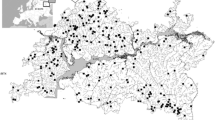Abstract
Habitat preferences can be identified from population density and electivity indices, which can be derived from either abundance or occurrence data. This study examined the preference detectability and independency of density and electivity indices from different data sources -- abundance and occurrence. Eight scenarios comprising four fish species along two environmental gradients (flow velocity and water depth) in an undisturbed mountain stream were used in this study. Fish density and seven electivity indices were calculated from abundance and occurrence data for the eight scenarios. The correlation analyses illustrated that abundance electivity indices were positively correlated with density in all eight scenarios while occurrence electivity indices were positively correlated with density in only three scenarios. Electivity indices were positively correlated with each other within the same data quality (abundance or occurrence) but not between. The Chesson’s L index was less correlated with other indices and should be used cautiously. Natural historical traits, such as social interactions among organisms, may affect the preference performance of density and electivity indices. In conclusion, density is a good preference indicator. Abundance electivity indices can represent density while occurrence electivity density should be used cautiously for fast assessment. Three electivity indices, Ivlev’s E and E′ and Jacobs’ D, were recommended for their ease of understanding.




Similar content being viewed by others
References
Aadland LP (1993) Stream habitat types: their fish assemblages and relationship to flow. North Am J Fish manag 13:790–806
Bain MB, Finn JT, Booke HE (1985) A quantitative method for sampling riverine microhabitats by electrofishing. North Am J Fish manag 5:489–493
Block WM, Brennan LA (1993) The habitat concept in ornithology. Curr Ornithol 11:35–91
Chesson J (1978) Measuring preference in selective predation. Ecology 59:211–215
Chou WC, Chuang MD (2011) Habitat evaluation using suitability index and habitat type diversity: a case study involving a shallow forest stream in central Taiwan. Environ Monit Assess 172:689–704
Fretwell SD, Lucas HL (1969) On territorial behavior and other factors influencing habitat distribution in birds. I. Theoretical development. Acta Biotheor 19:16–36
Garner P (1995) Suitability indices for juvenile 0+ roach using point abundance sampling data. Regul Rivers Res Manag 10:99–104
Glozier NE, Culp JM, Scrimgeour GJ (1997) Transferability of habitat suitability curves for a benthic minnow, Rhinichthys cataractae. J Freshw Ecol 12:379–393
Gorman OT, Karr JR (1978) Habitat structure and stream fish communities. Ecology 59:507–515
Grinnell J (1917) The niche-relationships of the California thrasher. Auk 34:427–433
Grossman GD, Freeman MC (1987) Microhabitat use in a stream fish assemblage. J Zool 212:151–176
Ivlev VS (1961) Experimental ecology of the feeding of fishes. Yale University Press, New Haven
Jacobs J (1974) Quantitative measurement of food selection. Oecologia 14:413–417
Lechowicz MJ (1982) The sampling characteristics of electivity indices. Oecologia 52:22–30
Lee PY, Rotenberry JT (2005) Relationships between bird species and tree species assemblages in forested habitats of eastern North America. J Biogeogr 32:1139–1150
Lee PY, Suen JP (2012) Niche partitioning of fish assemblages in a mountain stream with frequent natural disturbances - an examination of microhabitat at riffle areas. Ecol Freshw Fish 21:255–265
Lee PY, Suen JP (2013) Comparing habitat suitability indices based on abundance data versus occurrence data. North Am J Fish Manag 33(1):89–96. doi:10.1080/02755947.2012.743933
Martin-Smith KM (1998) Relationships between fishes and habitat in rainforest streams in Sabah, Malaysia. J Fish Biol 52:458–482
Moyle PB, Vondracek B (1985) Persistence and structure of the fish assemblage in a small California stream. Ecology 66:1–13
Scott TA, Lee PY (2013) Reconciling social interaction with habitat selection in territorial species. Theory Biosci 132:41–46. doi:10.1007/s12064-012-0166-z
Strauss RE (1979) Reliability estimates for Ivlev’s electivity index, the forage ratio, and a proposed linear index of food selection. Trans Am Fish Soc 108:344–352
Suen JP, Su WC (2010) Reconstructing riverine mesohabitat unit composition using fish community data and an autecology matrix. J Fish Biol 77:972–984
Tanentzap AJ, Bee JN, Lee WG, Lavers RB, Mills JA, Mark AF, Coomes DA (2009) The reliability of palatability estimates obtained from rumen contents analysis and a field-based index of diet selection. J Zool 278:243–248
Vanderploeg HA, Scavia D (1979a) Two electivity indices for feeding with special reference to zooplankton grazing. J Fish Res Board Can 36:362–365
Vanderploeg HA, Scavia D (1979b) Calculation and use of selectivity coefficients of feeding: zooplankton grazing. Ecol Model 7:135–149
Van Horne B (1983) Density as a misleading indicator of habitat quality. J Wildl Manag 47:893–901
Acknowledgments
The authors gratefully acknowledge the research support of the National Science Council, Taiwan, under grant numbers NSC 100-2628-E-006-014 and 100-2811-E-006-048 and College of Engineering at National Cheng Kung University under grant number D102-33002. We also thank A.C. Marcinkevage and two anonymous reviewers for comments and suggestions and Wei-Che Su, Shih-Kai Chou, Tsung-Chi Chang, Ying-Sheng Lyu, Ruei-Hong Wang, Ting-Hsiang Huang, Hung-Nien Lai, Chi-Hsien Chiu, and Chin-Yuan Lin for field assistance. Electrofishing was approved by the Agriculture Council, Taiwan and fish handling followed the regulation of animal care and ethics committee.
Author information
Authors and Affiliations
Corresponding author
Rights and permissions
About this article
Cite this article
Lee, PY., Suen, JP. Dependency and independency among fish density and electivity indices in a stream fish assemblage. Environ Biol Fish 97, 111–119 (2014). https://doi.org/10.1007/s10641-013-0129-3
Received:
Accepted:
Published:
Issue Date:
DOI: https://doi.org/10.1007/s10641-013-0129-3




